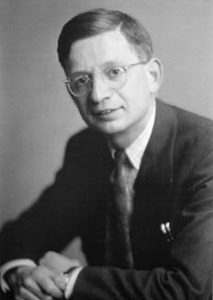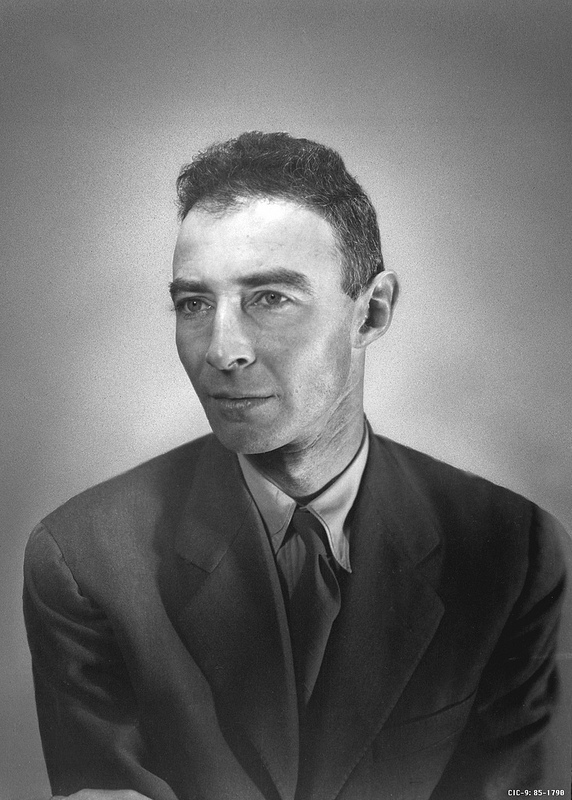The Atomic Heritage Foundation is pleased to present the Martin J. Sherwin Collection, focusing on the life of J. Robert Oppenheimer, on the “Voices of the Manhattan Project” oral history website. The collection is courtesy of historian and George Mason University Professor Martin J. Sherwin.
Oppenheimer, a theoretical physicist, proved to be an extraordinary choice to direct the Los Alamos laboratory, the center for scientific research on the atomic bomb during the Manhattan Project in World War II. Like many of his peers, physicist Robert Christy joined the Manhattan Project because of one man: J. Robert Oppenheimer. “Oppenheimer asked if I would join him in Los Alamos. I said I would be delighted because like most of his students, I would more or less follow him to the ends of the earth.”
The Sherwin Collection
Sherwin recorded audio interviews with dozens of Manhattan Project veterans and friends of Oppenheimer in the 1970s-80s, as he was preparing to write a biography of Oppenheimer, American Prometheus: The Triumph and Tragedy of J. Robert Oppenheimer. Sherwin wrote the book with historian and journalist Kai Bird. The book won the Pulitzer Prize in 2006 and is considered the premier Oppenheimer biography. Now for the first time, the interviews that Sherwin conducted are available to the public. Each interview includes an audio recording and transcript. The “Voices” website currently features 17 interviews from the Sherwin Collection; AHF plans to upload the remaining interviews over the next year or so as funding is available.
The Sherwin Collection includes interviews with about 60 people, many of whom worked on the Manhattan Project with Oppenheimer. Others had been friendly with him and his family at Caltech and the University of California-Berkeley, the Institute for Advanced Study at Princeton, and St. John in the Caribbean. The interviews cover much of Oppenheimer’s life, from his graduate school days to his death. They trace Oppenheimer’s transformation from a magnetically brilliant professor, often deep in thought surrounded by young physicists, to a focused wartime laboratory director. Some interviewees recall how the 1954 Atomic Energy Commission security hearing that stripped Oppenheimer of his security clearance – ending his influence on nuclear weapons policy – affected him and his family.
The Sherwin Collection interviews provide a kaleidoscope of reflections on the many facets of Oppenheimer’s personality, career, and his relationship with his family. They offer a more complete understanding of Oppenheimer’s persona and his many roles: left-wing sympathizer at Berkeley, theoretical physicist, Manhattan Project leader, and nuclear weapons policymaker.
A Treasure Trove

Sherwin is very pleased to see the interviews published on “Voices.” He remarked, “The 50 or more recorded interviews I conducted beginning in 1979 became the foundation of our Oppenheimer biography. It appears that my timing was perfect since almost everyone I contacted was ready to talk at length and in detail about their recollections of Oppenheimer. No one was inhibited by being recorded.
“I began my interviews with a few obvious colleagues and with every interview gathered more names. Every one of the interviewees was engaging in his or her own right, and their range of interests reflected the amazing breadth of Oppenheimer’s interests. I would urge every biographer, historian or journalist to record their interviews. In the long run, if they are in depth, they are treasures for future biographers and historians. Thanks to the Atomic Heritage Foundation for making them available to interested readers.”
Kai Bird explained the significance of the oral history collection: “I only realized the unique value of these brilliant interviews when I joined Marty Sherwin on his Oppenheimer project. This was in the year 2000—and many of the interviews had been conducted back in the 1980s. Marty warned me that the interviews were good, but perhaps there were gaps, particularly related to Oppenheimer’s life in Berkeley in the 1930s. It turned out he was being unduly modest, or maybe he was trying to lower my expectations.
“When I began to read the interviews I realized that he had built, interview by interview, a treasure trove of historical information about Oppenheimer, quantum physics and American political life in the 20th century. Marty was just very skillful in the subtle art of getting people to talk!”
A Portrait of Oppenheimer
 J. Robert Oppenheimer has long been recognized as a complicated man who provoked complicated emotions. Some of the interviewees fondly recall Oppenheimer’s ability to inspire his students and his leadership during the Manhattan Project. Alice Kimball Smith joined her husband, metallurgist Cyril Smith, at Los Alamos. Smith found Oppenheimer “helpful, thoughtful, and extraordinarily kind and pleasant.” After the war, Smith edited a volume of Oppenheimer’s letters.
J. Robert Oppenheimer has long been recognized as a complicated man who provoked complicated emotions. Some of the interviewees fondly recall Oppenheimer’s ability to inspire his students and his leadership during the Manhattan Project. Alice Kimball Smith joined her husband, metallurgist Cyril Smith, at Los Alamos. Smith found Oppenheimer “helpful, thoughtful, and extraordinarily kind and pleasant.” After the war, Smith edited a volume of Oppenheimer’s letters.
Polish physicist Joseph Rotblat, who worked on the project at Los Alamos, explained why he was impressed by Oppenheimer: “Immediately he struck me as a person who was very quick, highly intelligent. I noticed straightaway that he could take things in almost instantaneously. From this perspective, he was a genius. I am not surprised that he managed to be such a good director for the laboratory.”
But not everyone shared such a rosy view of Oppenheimer’s character or abilities. Marvin Goldberger, who worked on the Manhattan Project at Chicago and later became president of Caltech, found Oppenheimer to be a very challenging person when they met after the war. “He was a difficult person to be with under any circumstances. It was almost as though he were acting continuously. In spite of having been very close to him for ten years, I never felt that I was really close to him, that I really understood him. He took great pleasure in putting people down.”
While many praise Oppenheimer for his genius and wide-ranging abilities, they also puzzle over Oppenheimer’s place in the pantheon of American physics. Stanislaus Ulam, who worked on the Manhattan Project and helped design the hydrogen bomb, explained, “When he came back from Germany in 1932, he was regarded the great hope of American physics. It didn’t pan out that way.” Milton Plesset, who was one of Oppenheimer’s colleagues at Caltech, stated, “He never felt—and I think he was right in that feeling—that he made the outstanding accomplishments that his abilities justified.”
The interviews also shed light on Oppenheimer’s relationship with his family. Sherwin asked the interviewees insightful questions to draw out observations on Oppenheimer’s family life, and how his work and the security hearing impacted him and his wife and children. Goldberger described Oppenheimer’s sense of loss after his security clearance was revoked: “He felt very lost, being out of the national security advisory business. I used to talk with him about what I was doing, to try to give him sort of the flavor of the kinds of things that we were worrying about, because he was very eager for that kind of feeling of involvement.”
Many of the interviewees were critical of Oppenheimer’s wife Kitty, a botanist by training who struggled with alcoholism and could be acerbic. Verna Hobson, who worked as Oppenheimer’s secretary at the Institute for Advanced Study, remembered, “Kitty had a certain need to hurt people.” But she praised Kitty for being Oppenheimer’s “greatest confidante and advisor,” especially during the security trial hearing. “It brought out the very best in her. It called on all of her faculties, and it was probably the only time in her life she ever really felt that she was being demanded something that really used her capabilities. She was brave.”
Nuclear Weapons Policy and Other Themes

Sherwin asked the Manhattan Project veterans about their work on the project and their thoughts on nuclear weapons policy. Many provide thoughtful reflections on their Manhattan Project experience and the Cold War world. Rotblat, who was the only scientist to leave the Manhattan Project ostensibly for moral reasons and won the 1995 Nobel Peace Prize for co-founding the Pugwash Conferences, recalled “the mental torture” he experienced while debating whether to work on the atomic bomb project.
Sir Rudolf Peierls, who worked on the project at Los Alamos, remembered the scientists’ reactions to the successful Trinity Test in July 1945: “My recollection is that many people felt like celebrating—partly because this was in the military sense a great victory, and partly because it had made the work of Los Alamos tremendously important. I think I am right in saying that many of us must felt—giving myself credit there—that it was not an occasion for celebrating.”
In addition to insights on Oppenheimer and his family, the Sherwin Collection sheds light on a variety of other topics. Sherwin explored many other themes in the interviews, including: the communist movement at Berkeley in the 1930s; the Manhattan Project at Los Alamos and the relationships among the scientists; the government investigations of scientists accused of being communists or communist sympathizers; the development of the hydrogen bomb and American nuclear policy; and the institutions where Oppenheimer worked and their social dynamics.
J. Robert Oppenheimer’s character and his career continue to fascinate historians and the general public. The Sherwin Collection on AHF’s “Voices of the Manhattan Project” website will inform historical scholarship on Oppenheimer’s life, and many other issues, for decades to come.
Thank You
The Atomic Heritage Foundation thanks Martin J. Sherwin and the Library of Congress for their support in publishing the Sherwin Collection on the “Voices of the Manhattan Project” website. AHF is grateful to Crystal Trust and the M. J. Murdock Charitable Trust for their financial support of AHF’s oral history project.





